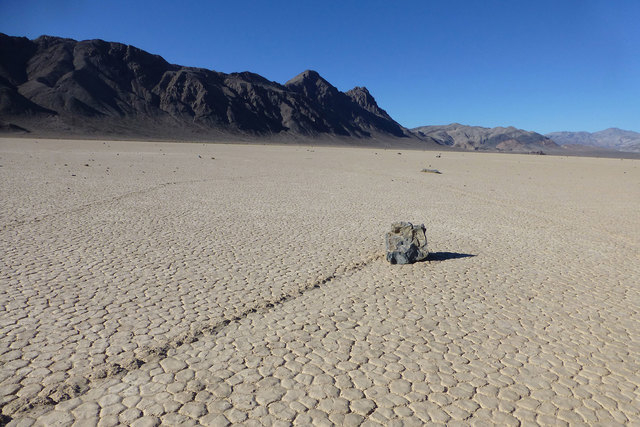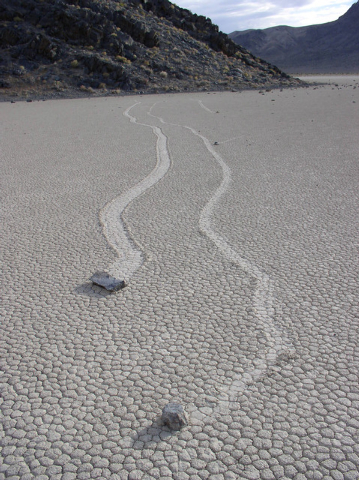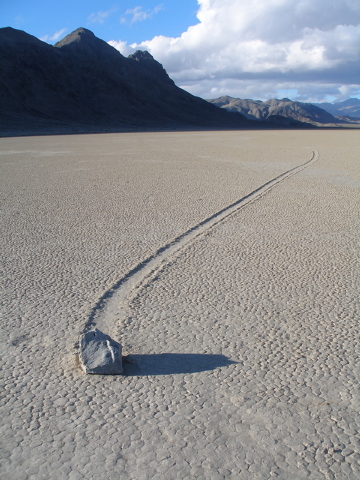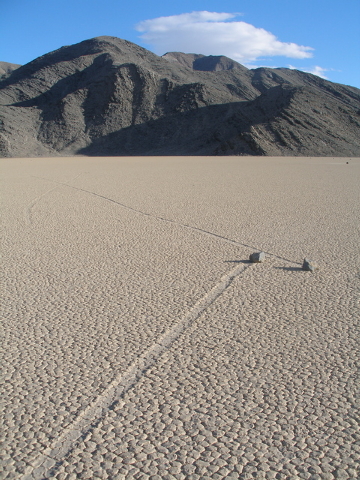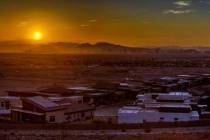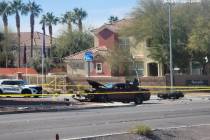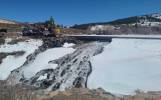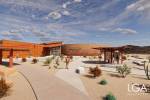Death Valley’s moving rocks caught in the act
One of Death Valley’s most enduring mysteries has been solved by what one researcher called “the most boring experiment ever.”
For decades, people have puzzled over Racetrack Playa, where hundreds of rocks weighing as much as 700 pounds roam across the surface of the dry lake bed, leaving meandering tracks hundreds of yards long.
Researchers have investigated the phenomenon since the 1940s, but all they ever produced was speculation. No one ever actually saw the rocks move.
Until now.
The first ever observations, which came in December, are documented in a new paper published Wednesday in the scientific journal PLOS ONE by a research team that set out to solve the mystery, once and for all.
“We expected to wait five or ten years without anything moving, but only two years into the project, we just happened to be there at the right time to see it happen in person,” said Richard Norris, a paleobiologist from Scripps Institution of Oceanography at the University of California, San Diego. “It’s just the most amazing thing to see all that play out.”
It turns out the key ingredient for moving rocks in North America’s hottest place is floating ice.
The process works like this: First, the playa must fill with just the right amount of water, deep enough for floating ice to form during cold winter nights but shallow enough to expose the rocks. Then the pond freezes into sheets of “windowpane” ice thin enough to move freely but thick enough to maintain its strength.
When the ice begins to melt, it breaks into large floating panels that even light winds can drive across the shallow pool. As the ice sheets move, they slowly push the rocks in front of them, causing them to leave trails in the soft, slippery mud below the water’s surface.
“It’s like the Goldilocks thing. Everything has to be just right,” Norris said.
He and his cousin and co-author James Norris were the first to actually see the process in action, though they never expected to. They traveled to the remote Eastern California playa on a rough dirt road more than 200 miles northwest of Las Vegas to check their test subjects: 15 specially quarried stones embedded with motion-activated GPS sensors and placed on the dry lake two years earlier, with Park Service permission.
The Norrises arrived to find the Racetrack covered with water. Then, just before noon on Dec. 21, they watched in astonishment as the ice started to crack and break apart, and the rocks began, ever so subtly, to shift.
Jim Norris managed to capture the action in series of still pictures that he strung together to make a one-of-a-kind movie.
“Jim and I were just grinning at each other when we finally came off the mountainside,” Norris said.
The researchers eventually charted individual rockslides that lasted from a few seconds to 16 minutes. They also recorded rocks three football fields apart that moved simultaneously for more than 200 feet in a single trip.
In the process, they may have solved another mystery: tracks left in the mud with no rock in sight. The Park Service has long suspected that tourists were stealing stones from the playa, leaving behind tracks with no rocks at the end of them, but the researchers found that the ice panels themselves appear to carve trails in the mud before melting without a trace.
Previous theories for the strange rock movements at the Racetrack and a handful of other spots, including Bonnie Claire dry lake in Nevada, involved hurricane-force winds, dust devils, slick algal films or ice sheets thick enough to lift the stones up and drag them along a flat dry lake bed.
“We all thought it was really powerful wind that was driving the rocks,” Norris said.
Instead, they discovered that the rocks could be pushed by winds of just 10 mph and ice no thicker than window glass.
But this is far from a real racetrack. The rocks only move a few inches per second, a speed almost imperceptible when you’re standing on the shore of the soupy, wet playa and watching from a distance. Norris said it’s entirely possible that visitors have been there before when it was happening but just couldn’t see it.
“It doesn’t look like they’re moving, but they’re moving very slowly,” he said.
The “most boring experiment ever” comment came from another of the paper’s authors, Ralph Lorenz of the Applied Physics Laboratory at Johns Hopkins University, and he was not wrong. The project promised years of monotony punctuated by regular trips to the hard-to-reach playa to replace batteries on the GPS units and download data from the weather station the researchers built nearby.
“We had a three-year permit from the park for our experiment, and we had every expectation that we would have to renew it one or more times,” Norris said.
Now that they have their answer, he said it’s hard not to feel slightly wistful over the loss of one of the Mojave’s most compelling mysteries. But there’s no denying they were in exactly the right place at exactly the right time. Norris said what happened in December was probably the best “move event” the playa has seen in 15 years. And Dec. 21, the day they finally caught the phenomenon on camera, was Jim’s birthday.
At least one puzzle remains. Though researchers recorded rocks moving five different times over 10 weeks, including one event that involved hundreds of stones, they never caught so much as a budge from any of the “really big boys” out on Racetrack Playa. Which leads Norris, as ever, to a question: “Does that work the same way?”
Contact Henry Brean at hbrean@reviewjournal.com or 702-383-0350. Follow @RefriedBrean on Twitter.



